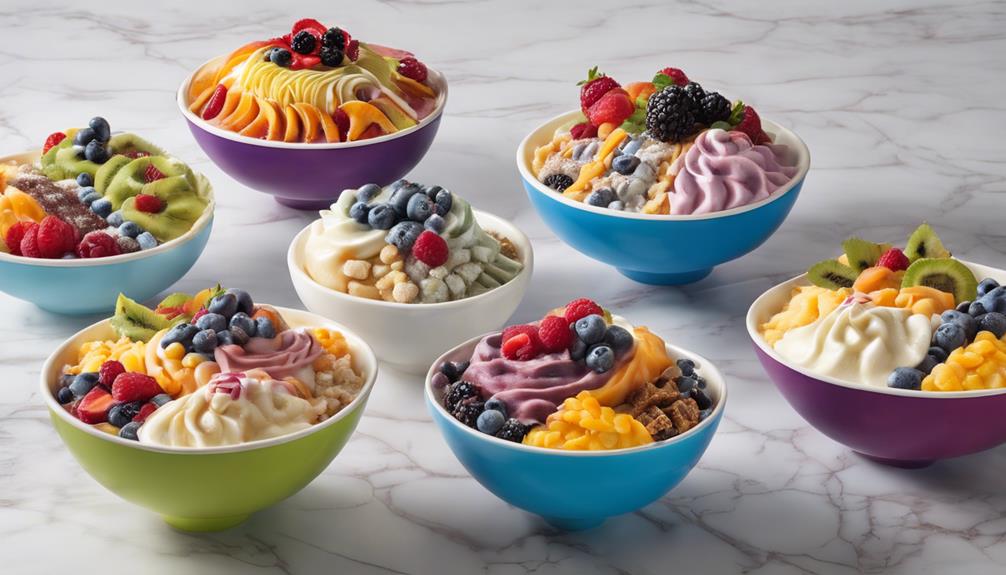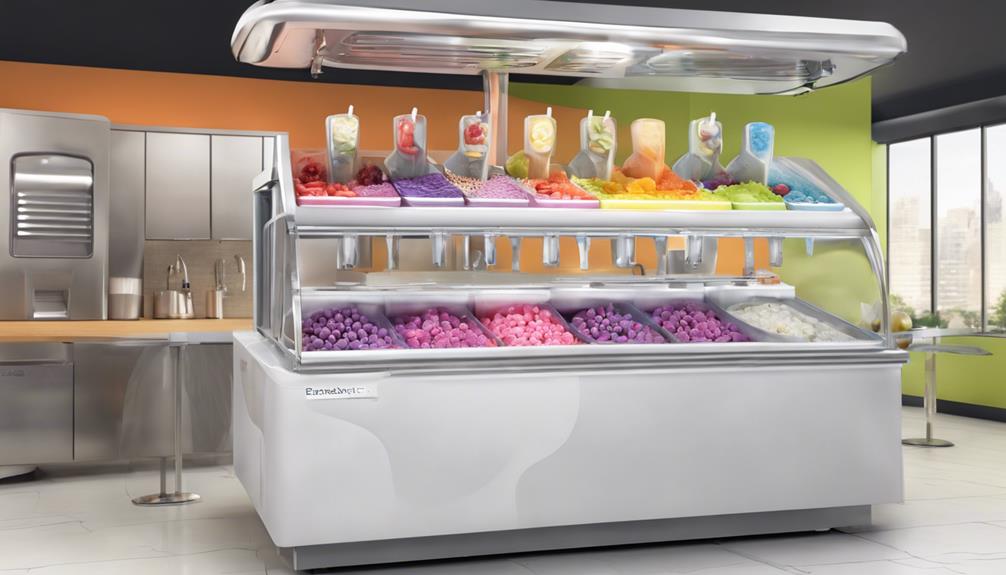Imagine walking into a frozen yogurt shop, where the air is filled with the scent of fresh toppings and the hum of self-service machines. You're not just choosing a dessert; you're making a lifestyle choice. In the 21st century, frozen yogurt has transformed from a niche indulgence to a health-conscious favorite, offering lower sugar and fat content compared to traditional ice cream. With innovative flavors and inclusive options like vegan and dairy-free, it's more than just a treat—it's a reflection of modern dietary trends. So, how did frozen yogurt achieve such widespread appeal?
Key Takeaways
- Frozen yogurt has evolved with innovative flavors like matcha green tea and vegan options, catering to diverse consumer preferences.
- Self-service machines enhance customer experience by offering customizable flavors, portion control, and interactive engagement.
- Health-conscious consumers drive market growth, preferring frozen yogurt's lower sugar, fat, and calorie content over traditional ice cream.
- Frozen yogurt chains like Pinkberry and Yogurtland lead market expansion through continuous innovation in menu offerings.
- Seasonal flavors and diverse toppings keep frozen yogurt menus dynamic and appealing to a broad audience.
Evolution of Frozen Yogurt
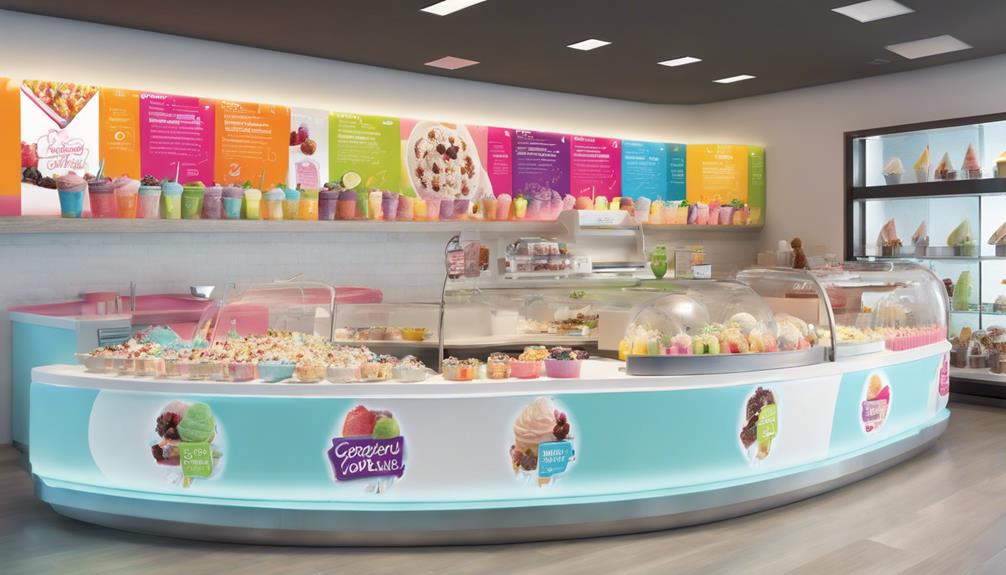
Frozen yogurt has consistently evolved since its introduction in the 1970s, reflecting shifts in consumer preferences and market trends. Initially launched by H.P. Hood, this soft-serve dessert pioneered a new category in frozen treats. The first major breakthrough came in 1981 when TCBY opened the inaugural frozen yogurt shop, carving out a niche as an alternative to ice cream. By 1986, the industry had burgeoned into a $25 million market, capturing 10% of the frozen dessert segment by the 1990s.
The early 21st century marked another significant evolution with the debut of Pinkberry in 2005. This era saw a renaissance in frozen yogurt shops, which became trendy destinations offering a variety of flavors and toppings. These shops catered to the growing consumer demand for healthier dessert options, emphasizing lower-fat content and innovative flavors. Frozen yogurt's market continued to expand, projected to reach $2.1 billion by 2019.
The evolution of frozen yogurt underscores a broader shift towards customizable treats. As consumers increasingly seek out healthier alternatives to traditional ice cream, frozen yogurt shops have adapted by offering diverse options tailored to these preferences, maintaining their market relevance.
Healthier Alternatives
As consumer preferences evolved, the focus on healthier alternatives like frozen yogurt has become increasingly prominent due to its lower sugar, fat, and carbohydrate content compared to traditional ice cream. This shift is driven by a growing awareness of dietary health and the demand for nutritious dessert options. Frozen yogurt, often perceived as a healthier dessert option, offers a lower calorie count, making it an attractive choice for those mindful of their caloric intake.
The rise of frozen yogurt in the 21st century can be attributed to these health benefits. Many individuals with lactose allergies can also enjoy frozen yogurt, as it generally contains lower levels of lactose than ice cream. This inclusivity further enhances its appeal as a versatile dessert alternative.
Frozen yogurt shops have capitalized on this trend, proliferating rapidly to meet the increasing demand for healthier dessert options. These establishments offer a variety of products that cater to health-conscious consumers, thereby driving market growth. The lower sugar, fat, and carbohydrate content of frozen yogurt aligns with modern dietary preferences, reinforcing its status as a preferred choice over traditional ice cream for a growing segment of the population.
Innovative Flavors
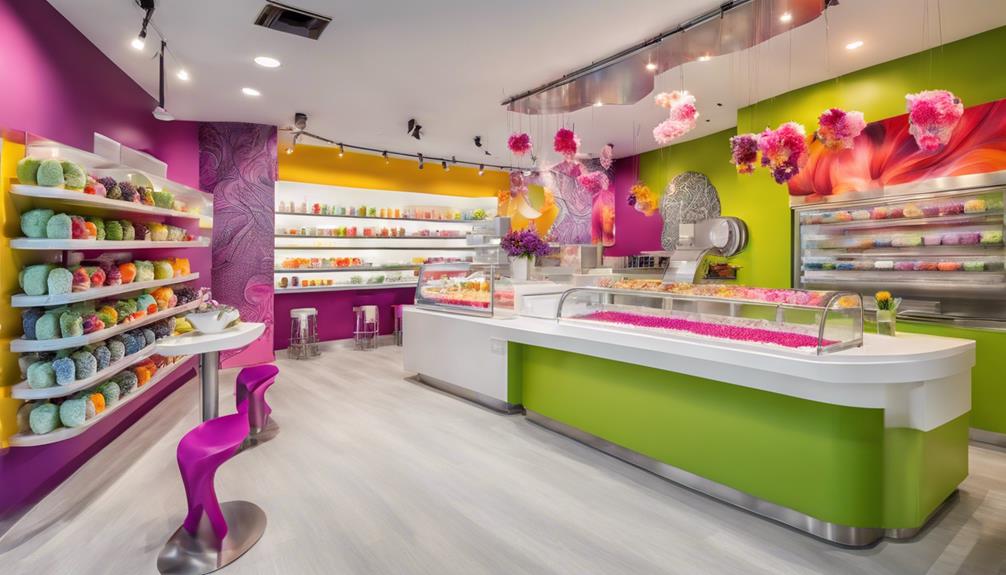
Embracing a trend towards culinary creativity, the 21st-century frozen yogurt market has introduced innovative flavors such as matcha green tea, salted caramel, and honey lavender to attract discerning consumers. These flavors not only diversify the palate but also cater to a growing demand for unique taste experiences.
The introduction of such flavors can be attributed to a few key factors:
- Consumer Demand: Modern consumers seek distinctive and novel flavors, pushing frozen yogurt shops to innovate continually.
- Health Trends: As customers become more health-conscious, flavors like matcha green tea, known for its antioxidant properties, align with these preferences.
- Seasonal Offerings: Seasonal flavors like pumpkin spice in the fall and peppermint mocha in winter keep the menu dynamic and appealing.
Additionally, the choice of toppings plays an essential role in enhancing the frozen yogurt experience. Popular toppings such as fresh fruit, chia seeds, granola, and mochi provide textural contrast and nutritional benefits, making the treat both delicious and wholesome. Moreover, the emergence of vegan and dairy-free frozen yogurt options ensures inclusivity for those with dietary restrictions, expanding the market reach. These innovative flavors and toppings reflect a strategic approach to meet diverse consumer preferences in the evolving frozen yogurt industry.
Self-Service Machines
Self-service machines have revolutionized the frozen yogurt industry by offering customers a highly customizable and interactive dessert experience. These machines empower you to dispense the exact amount of frozen yogurt you desire, thereby eliminating waste and providing control over portion size. The variety of flavors available through self-service machines enhances your ability to mix and match, creating unique combinations tailored to your personal taste preferences.
In frozen yogurt shops, self-service machines have become a cornerstone of the customer experience. They facilitate a streamlined and efficient process, allowing you to quickly and easily serve yourself without waiting for staff assistance. This model not only reduces labor costs but also increases customer satisfaction by making the dessert experience both convenient and engaging.
The ability to add a multitude of toppings further enhances the customizable dessert experience. You can experiment with different textures and flavors, from fruits and nuts to candies and syrups, crafting a dessert that's uniquely yours. The interactive nature of self-service machines makes the process enjoyable, contributing to the overall appeal and success of frozen yogurt shops in the 21st century. This technological innovation has undeniably set a new standard in the frozen yogurt industry.
Market Trends
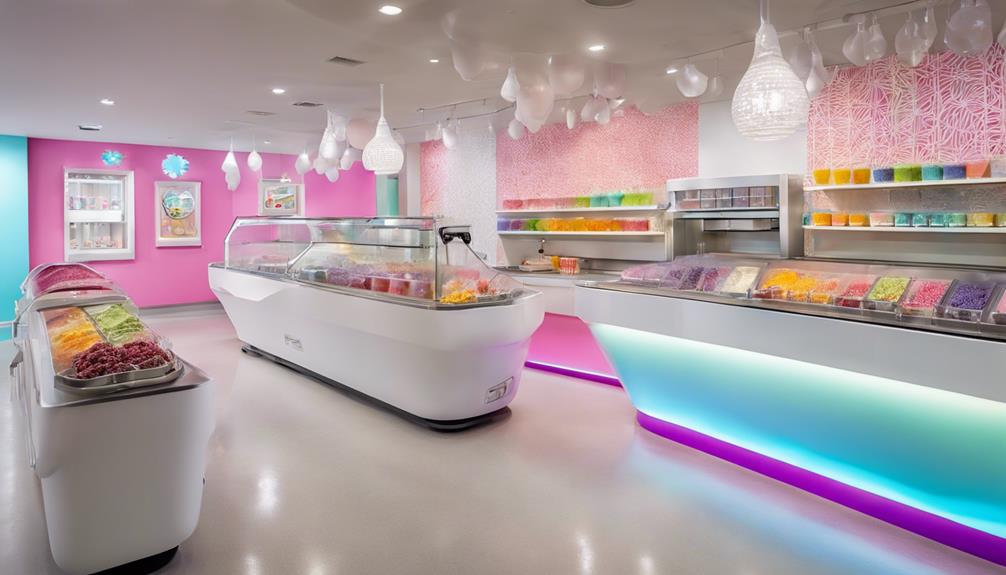
Building on the success of self-service machines, the frozen yogurt market has demonstrated robust growth, reaching $2.1 billion in revenue by 2019. This significant market presence highlights the enduring appeal of froyo shops in the United States. The rise of prominent frozen yogurt chains such as Pinkberry, Handles, Menchies, Topzz, Llaollao, and Yogurtland during the late-2000s and early 2010s underscores the trend of frozen yogurt becoming a trendy alternative to traditional ice cream stores.
Several key market trends have emerged:
- Resilience Despite Challenges: Despite economic fluctuations and evolving consumer preferences, many froyo businesses have shown stability, indicating a resilient market.
- Consumer Preferences: There's a noticeable shift towards healthier dessert options, with frozen yogurt capturing 10% of the frozen dessert market back in the 1990s. This trend continues to drive demand.
- Innovation in Offerings: Froyo shops increasingly offer a variety of flavors, toppings, and customizations, catering to diverse consumer tastes and enhancing customer engagement.
Analyzing these trends reveals that frozen yogurt chains in the United States are well-positioned to adapt and thrive. The market's growth and resilience underscore its potential for continued expansion and innovation in the 21st century.
Frequently Asked Questions
What Happened to the Frozen Yogurt Trend?
You saw the frozen yogurt trend decline due to market saturation, changing consumer preferences, and skepticism towards its health craze claims. The rise of dairy-free options and reduced flavor variety further impacted its popularity.
When Did Frozen Yogurt Become Popular?
Frozen yogurt gained popularity in the late 2000s and early 2010s. Its rise was driven by perceived health benefits, flavor innovations, and market expansion, making it a trendy alternative to traditional ice cream.
What Happened to Elan Frozen Yogurt Brigham?
Elan Frozen Yogurt Brigham, once a star in the frozen yogurt galaxy, faced brand evolution challenges. Market competition intensified, leading to product discontinuation. The chain couldn't adapt to the shifting market dynamics and ultimately closed down.
What Happened to Pinkberry Frozen Yogurt?
Pinkberry's branding, bolstered by celebrity endorsements and aggressive franchise expansion, initially fueled its success. However, legal challenges and market saturation in the 2010s led to store closures and a decline, tarnishing its once-iconic status.
Conclusion
To sum up, you've witnessed how frozen yogurt has transformed into a modern-day sensation. Providing healthier alternatives, creative flavors, and self-service options, it's no wonder it has captured the hearts of many. As indicated by market trends, the desire for personalized and health-conscious treats shows no signs of slowing down. Like a well-oiled machine, the industry continues to adapt and thrive, ensuring frozen yogurt remains a beloved choice for consumers in the 21st century.


